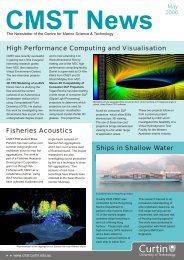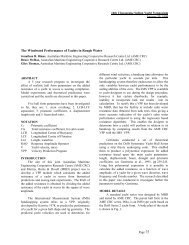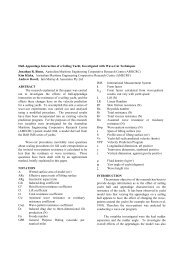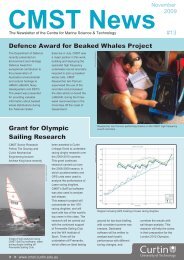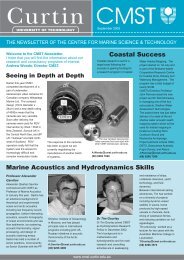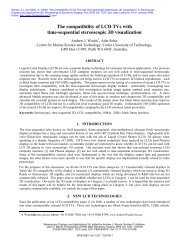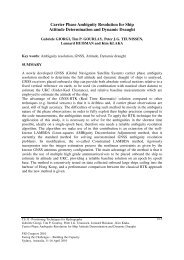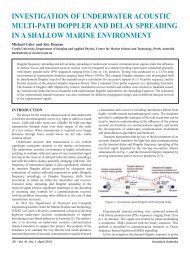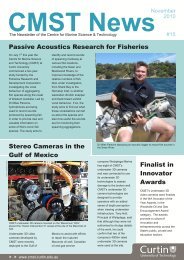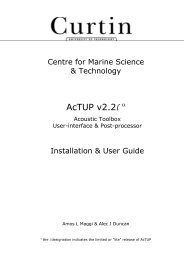western australia - Centre for Marine Science and Technology ...
western australia - Centre for Marine Science and Technology ...
western australia - Centre for Marine Science and Technology ...
You also want an ePaper? Increase the reach of your titles
YUMPU automatically turns print PDFs into web optimized ePapers that Google loves.
WESTERN<br />
AUSTRALIA<br />
Defence Industry grows in WA AMC key to defence industry Skilled work<strong>for</strong>ce in WA
Western Australia<br />
The logical choice<br />
Western Australia is the logical choice <strong>for</strong><br />
industry serious about module fabrication,<br />
ship consolidation, repair <strong>and</strong> maintenance<br />
<strong>for</strong> naval <strong>and</strong> commercial vessels.<br />
The Australian <strong>Marine</strong> Complex (AMC) in Cockburn<br />
Sound, Western Australia, is the perfect location to<br />
undertake this type of work <strong>and</strong> is being developed<br />
to accommodate the Royal Australian Navy’s (RAN)<br />
upcoming Amphibious vessel build program.<br />
In addition to the initial $200 million State <strong>and</strong> Federal<br />
Government funding to establish the successful<br />
Common Use Facility (CUF) at the AMC, the Western<br />
Australian Government has invested a further<br />
$90 million in infrastructure to meet the ongoing<br />
requirements of naval <strong>and</strong> commercial ship fabrication,<br />
consolidation, repair <strong>and</strong> maintenance. This will make<br />
Western Australia the most capable location to build<br />
<strong>and</strong> consolidate vessels of the size required by RAN.<br />
The $90 million of new infrastructure includes:<br />
• A floating dock to launch <strong>and</strong> dock large ships <strong>and</strong> a<br />
rail transfer system to allow construction <strong>and</strong> repair<br />
within the CUF’s undercover facilities.<br />
• An extension <strong>and</strong> upgrade of the existing wharves<br />
to accommodate all types of naval <strong>and</strong> commercial<br />
vessels.<br />
• The installation of marine services such as power,<br />
seawater firemain, wharf communications <strong>and</strong><br />
sewerage offtake.<br />
The $90 million infrastructure works will be completed<br />
in time to meet the upcoming naval construction<br />
program timeframes, with planning already<br />
commenced <strong>and</strong> tenders to be let shortly.
Investing in success<br />
The AMC provides numerous advantages <strong>for</strong> ship<br />
fabrication, consolidation, repair <strong>and</strong> maintenance<br />
requirements <strong>for</strong> naval <strong>and</strong> commercial operations<br />
including:<br />
• Proven world-class infrastructure <strong>and</strong> enhancement<br />
of this infrastructure with a further $90 million worth<br />
of capability.<br />
• A work<strong>for</strong>ce skilled in naval <strong>and</strong> commercial ship design<br />
<strong>and</strong> construction.<br />
• 80ha of laydown areas with abundant room to grow.<br />
• Economies of scale from having half of Australia’s<br />
commercial shipbuilding activity at the AMC <strong>and</strong><br />
complementary skills from the booming offshore<br />
fabrication industry.<br />
• A sophisticated integrated support capability supported<br />
by a strong industry base.<br />
• A dedicated purpose built facility that is free of the<br />
operating restrictions that apply to older urbanised<br />
shipyards.<br />
• A proactive <strong>and</strong> supportive State Government.<br />
The AMC is already the logical choice <strong>for</strong>:<br />
• The $60 million conversion of the Delos tanker <strong>for</strong> the<br />
RAN being undertaken by Tenix at the AMC-CUF.<br />
• $500 million upgrades to the Anzac frigates through the<br />
ANZAC Alliance Group.<br />
• Austal Ships producing the:<br />
o RAN Armidale Patrol Boats worth $350 million; <strong>and</strong><br />
o design of the US Navy’s new Littoral Combat Ships,<br />
part of a initial US$230 million contract<br />
• Raytheon Australia’s naval systems division<br />
headquarters.<br />
The AMC is also the upcoming location <strong>for</strong>:<br />
• ASC Pty Ltd’s new $20 million submarine repair <strong>and</strong><br />
maintenance facility.<br />
• $13 million Challenger TAFE engineering training<br />
facility, providing a skilled <strong>and</strong> trained work<strong>for</strong>ce.<br />
All of this makes the West the best location <strong>and</strong><br />
logical choice <strong>for</strong> shipbuilders <strong>and</strong> repair <strong>and</strong><br />
maintenance operators.<br />
Don’t miss your opportunity to get on board, contact<br />
Mr John O’Hare, General Manager, <strong>Marine</strong> & Defence,<br />
Australian <strong>Marine</strong> Complex at the Department of<br />
Industry <strong>and</strong> Resources on +61 8 9222 0966 or via<br />
email at john.o’hare@doir.wa.gov.au<br />
DoIRMAY06_707-C
New Minister pushes defence<br />
in Western Australia<br />
rancis Logan was appointed Minister <strong>for</strong> Energy; <strong>Science</strong> <strong>and</strong><br />
Innovation in Western Australia following a cabinet reshuffle in<br />
February 2006.<br />
Appointed by the new Premier, Alan Carpenter, his posting symbolised<br />
a significant shift in the economic focus of the Western Australian<br />
Government.<br />
“The resources sector has always been a strong contributor to the<br />
Western Australian economy,” Minister Logan said.<br />
“However, the boom won’t last <strong>for</strong>ever. We need to consider longterm<br />
sustainability <strong>for</strong> our economy <strong>and</strong> the way to achieve this is<br />
through encouragement of innovation <strong>and</strong> technological advancement<br />
<strong>and</strong> expansion.<br />
4<br />
F<br />
“There is huge potential <strong>for</strong> areas such as in<strong>for</strong>mation <strong>and</strong><br />
communications technology (ICT), biotechnology, bio-fuels <strong>and</strong> the<br />
marine <strong>and</strong> defence sector.<br />
“We only have to look at the Australian <strong>Marine</strong> Complex at<br />
Cockburn Sound to see what innovation <strong>and</strong> logical leadership can do<br />
<strong>for</strong> our economy.”<br />
As MLA <strong>for</strong> Cockburn Sound since 2001, the cluster of marine <strong>and</strong><br />
defence industry at the AMC has been a big part of Minister Logan’s<br />
political career <strong>for</strong> the past five years.<br />
In May this year the Federal Government released the $2 billion<br />
Amphibious ship tender that has the potential to place the successful<br />
bidder as a long term player in the shipbuilding industry.<br />
Local industry has put a strong case <strong>for</strong>ward <strong>for</strong> the warships to be built<br />
in Australia, despite the Defence Materiel Organsation casting doubt on<br />
the wisdom of building such vessels locally, reportedly saying there was<br />
‘no strategic reason <strong>for</strong> doing so’.<br />
However, the State Government has joined <strong>for</strong>ces with unions <strong>and</strong><br />
local businesses to support Western Australia’s bid to have the warships<br />
built here.<br />
The contract would see two 27,000 tonne amphibious vessels<br />
consolidated at the AMC over the next 10 years <strong>and</strong> would create about<br />
1500 jobs.<br />
In a detailed submission to the Senate in April 2006 Minister Logan<br />
emphasised the strategic <strong>and</strong> economic sense in building the vessels at<br />
the AMC.
“The State <strong>and</strong> Federal Governments have invested more than $270<br />
million to boost the capacity to construct, fabricate, repair <strong>and</strong> maintain<br />
such vessels at the AMC,” Minister Logan said.<br />
“The complex is more than capable of h<strong>and</strong>ling the project <strong>and</strong> with<br />
an abundance of skilled labour in WA it’s the ideal location <strong>for</strong> this<br />
project.”<br />
Since opening in 2003 the AMC has generated more than $55 million<br />
<strong>for</strong> the State’s economy <strong>and</strong> created about 800 full-time positions.<br />
The complex is already home to naval shipbuilding contractors<br />
<strong>and</strong> the common user facility enables businesses to lease facilities to<br />
complete projects without set-up costs.<br />
The first stage of the floating dock is capable of lifting 13,500 tonnes<br />
<strong>and</strong>, once the second stage is complete, will be capable of lifting up to<br />
27,000 tonnes.<br />
When completed, the floating dock will also have the ability to look<br />
after any future Royal Australian Navy (RAN) vessels <strong>and</strong> is located close<br />
to the RAN base at Garden Isl<strong>and</strong>.<br />
The State Government has invested A$26 million <strong>for</strong> the Challenger<br />
TAFE college within the technology precinct at the AMC.<br />
It is anticipated to open <strong>for</strong> enrolment at the start of 2007 <strong>and</strong> will<br />
offer courses through flexible learning packages <strong>for</strong> operator training in<br />
the oil <strong>and</strong> gas industry.<br />
Over the next three years Minister Logan also hopes that a dedicated<br />
marine-focused technology park will be established at the AMC.<br />
“Relevant companies spread throughout Perth are invited to take up<br />
residence at the AMC to create a world-class marine <strong>and</strong> defence cluster<br />
with everything in one spot,” Minister Logan said.<br />
CANBERRA “IGNORES” WA<br />
The Western Australian Government is opening a new office at<br />
Parliament House in Canberra in order to encourage the Federal<br />
Government to underst<strong>and</strong> Western Australia’s capabilities.<br />
“As one of the most isolated cities in the world Perth is often<br />
<strong>for</strong>gotten about by our east coast neighbours,” Minister Logan said.<br />
“However, with some of Australia’s biggest resource, oil <strong>and</strong> gas<br />
projects, a leading edge in areas such as biotechnology, ICT <strong>and</strong> medical<br />
research <strong>and</strong> close proximity to South East Asia, it makes tactical <strong>and</strong><br />
economic sense to assist growth here.<br />
RAN may use AMC <strong>for</strong> support<br />
The last ANZAC frigate will be delivered<br />
to Fremantle <strong>for</strong> its refit <strong>and</strong> upgrade. The<br />
fifth ship has undergone the process so far<br />
in WA. Under project SEA 1448 anti-ship<br />
missile defence upgrade “Tenix <strong>and</strong> Saab will<br />
design a package <strong>and</strong> when the work is to be<br />
declared WA is looking <strong>for</strong> a majority of the<br />
work,” says Mr Chris Eggleton, director of the<br />
ANZAC Systems Program Office at the DMO.<br />
The ANZAC ships are getting the Harpoon,<br />
an air weapons magazine (with Penguin <strong>and</strong><br />
MH90) <strong>and</strong> mine avoidance sonar upgrade<br />
during the refit. Asked whether the RAN will<br />
use the Common User Facility (CUF) at the<br />
AMC, Mr Eggleton replied that the Minister<br />
<strong>for</strong> Defence will have to decide if the AMC will<br />
be used or if Fleet Base West at Garden Isl<strong>and</strong><br />
will be upgraded.<br />
“A paper is being drawn up by the DMO <strong>for</strong><br />
the Minister giving the pros <strong>and</strong> cons of each<br />
choice. The final decision is expected in mid-<br />
2007,” he says.<br />
The ANZAC alliance is working from designs<br />
by Tenix <strong>and</strong> Saab <strong>and</strong> the work is then subcontracted<br />
out. “The DMO has its preferred<br />
suppliers within WA,” says Mr Eggleton. “This<br />
is where most of the work will take place <strong>and</strong><br />
we have never had a delay because of a skill<br />
shortage or lack of resources.”<br />
A ten-year ‘Naval Shipbuilding Plan’ is rewritten<br />
every year on the in-service support<br />
<strong>for</strong> the ANZAC ships as they are expected to<br />
be in service <strong>for</strong> between 20-30 years. Further<br />
work includes a system to go with the Phased<br />
Array Radar <strong>for</strong> the ship due <strong>for</strong> completion<br />
by 2009. Saab is undertaking the integration<br />
work in South Australia.<br />
“There is a centre of excellence here in WA<br />
teaching software development <strong>and</strong> testing.<br />
I would like to join up all the centres of<br />
excellence across Australia so that <strong>for</strong>ces are<br />
joined up be<strong>for</strong>e being deployed,” says Mr<br />
Eggleton.<br />
“We would like to link sailors <strong>and</strong> other<br />
users to their industry contacts so that any<br />
problems encountered can be referred to<br />
them, this means putting sailors inside the<br />
industrial process.”<br />
A research project has been conducted to<br />
see what effect the ANZAC ship project has<br />
had on Australia. Over A$400 million was<br />
spent on infrastructure be<strong>for</strong>e the ANZAC<br />
project was started <strong>and</strong> this money went into<br />
the Australian economy.<br />
“Communications upgrades <strong>for</strong> the<br />
ANZAC’s is next on the list,” Mr Eggleton<br />
concludes. ADI is currently looking at<br />
purchasing l<strong>and</strong> in the AMC in order to h<strong>and</strong>le<br />
the projects JP2008 Advanced SATCOM<br />
Terrestrial Infrastructure System (ASTIS)<br />
Maritime Communications Element (MCE) <strong>and</strong><br />
SEA1348 ANZAC Ship Project Underwater &<br />
Surface War Fighting Upgrade Program.<br />
The origins of the Alliance was set up in July<br />
2001, this has been “very successful”, says Mr<br />
Eggleton. “The new alliance arrangements will<br />
be signed off in July 2006.”<br />
5
Australian <strong>Marine</strong> Complex<br />
exp<strong>and</strong>s to attract fl eet works<br />
he Australian <strong>Marine</strong> Complex (AMC) in Western Australia (WA) is set<br />
to increase the capability of its facilities further with the construction<br />
of a floating dock capable of bringing large ships <strong>and</strong> submarines out<br />
of the water <strong>for</strong> maintenance work <strong>and</strong> upgrades.<br />
The AMC is a short distance from Fremantle, WA <strong>and</strong> is a facility made<br />
up of a series of large construction yards. Warehouses, a technology precinct<br />
<strong>and</strong> the Common User Facility (CUF).<br />
The CUF is an impressive module fabrication <strong>and</strong> construction facility that<br />
st<strong>and</strong>s out from the line of buildings housing the companies that use the<br />
facility. The CUF is owned <strong>and</strong> run by the Western Australian government<br />
with the buildings <strong>and</strong> facilities leased by companies that are presently<br />
working on naval projects.<br />
“Not only are we going to add a floating dock, but we are also extending<br />
the wharves <strong>and</strong> upgrading the capability of the facilities to go with them”<br />
said Mr John O’Hare, General Manager of the <strong>Marine</strong> & Defence Australian<br />
<strong>Marine</strong> Complex. “This will give us increased flexibility if a ship is running<br />
late <strong>for</strong> example it can remain alongside without having to be moved to<br />
accommodate a load out over the wharf.”<br />
Expressions of Interest were called <strong>for</strong> the first stage of the floating dock<br />
in January 2006 with four companies short-listed <strong>for</strong> the tender process.<br />
Tender documents were released 31 May <strong>and</strong> submissions close on 31 July.<br />
The contract is expected to be awarded in October <strong>and</strong> has a 18 month<br />
build process.<br />
The contract <strong>for</strong> construction of the Eastern Wharf extension was awarded<br />
on 2 June to John Holl<strong>and</strong> Pty Ltd <strong>and</strong> is expected to be completed within<br />
12 months.<br />
A number of other projects, including the dredging contract are<br />
progressing through the expression of interest <strong>and</strong> tender process.<br />
Mr O’Hare said the AMC was rapidly gaining an international reputation<br />
as the nation’s leading industrial facility <strong>for</strong> marine-related industries.<br />
“The expansion will ensure that a larger slice of billions of dollars worth<br />
of defence, marine <strong>and</strong> resource contracts come to <strong>and</strong> remain in Western<br />
Australia”.<br />
ADI <strong>and</strong> Tenix have indicated they are both interested in investing<br />
further into the AMC facility. Both companies have been in negotiations<br />
with the AMC.<br />
As part of the expansion ASC wants its new submarine <strong>and</strong> maintenance<br />
facility, adjacent to the CUF to be completed by March 2008 in order to<br />
meet its submarine through life support contracts with the RAN. This timing<br />
ties in with the completion date <strong>for</strong> the floating dock <strong>and</strong> transfer system.<br />
“The AMC is invaluable, not only to the military but also the civilian<br />
sector”, said Mr O’Hare, “The construction of plat<strong>for</strong>ms <strong>for</strong> export in the oil<br />
6<br />
T<br />
<strong>and</strong> gas sector could not have been done without this facility.”<br />
Mr O’Hare is confident that a work<strong>for</strong>ce to undertake the work on the<br />
amphibious vessel projects will not be a significant problem. “The A$2<br />
billion project pales in comparison when compared to the A$14 billion of<br />
projects undertaken in the north of the state <strong>for</strong> the oil <strong>and</strong> gas sector” he<br />
said, “it’s because this is a defence project that it raises peoples concerns.”<br />
With the Garden Isl<strong>and</strong> naval base directly opposite the AMC, becoming<br />
more a <strong>for</strong>ward operations centre <strong>for</strong> the RAN, rather than a repair shop,<br />
much of the work <strong>for</strong> construction, maintenance <strong>and</strong> overhaul of the RAN<br />
surface <strong>and</strong> sub-surface fleet will come here to the AMC, says Mr O’Hare. “It<br />
makes sense if the fleet is based nearby, repair work can then be completed<br />
close to their contractors rather than over on the east coast (of Australia).”<br />
The Royal Australian Navy signed a contract with the AMC in April-June<br />
2005 <strong>and</strong> is looking to extend this by a further six months. The Delos tanker<br />
replenishment ship, the replacement <strong>for</strong> HMAS Westralia, is undergoing its<br />
conversion at the CUF <strong>and</strong> is due to be completed <strong>for</strong> commencement of<br />
sea trials in August 2006.<br />
With a move towards a federal defence strategy the AMC concept is<br />
being copied elsewhere in areas such as Queensl<strong>and</strong> <strong>and</strong> the Northern<br />
Territories. The states <strong>and</strong> territory governments across Australia are coming<br />
round to the idea that defence work can be attracted if the right facilities<br />
are in place.<br />
Key components of the A$90 million CUF upgrade include:<br />
Extension to the Eastern Wharf to berth up to three naval vessels<br />
simultaneously.<br />
First stage of a floating dock (99m long) to transfer submarines <strong>and</strong><br />
other marine vessels to shore, capable of expansion in a second stage<br />
to launch <strong>and</strong> retrieve the navy’s future amphibious ships.<br />
Construction of a marine vessel rail transfer system<br />
Dredging works<br />
Upgrading the capacity of electricity <strong>and</strong> services to the facility
Perth becomes a niche IT centre<br />
T<br />
echnology company Calytrix has found its home in the niche<br />
environment of defence simulation that aims to help companies reduce<br />
the cost of their underlying IT infrastructure. Calytrix was founded in Western<br />
Australia in 2000 with a grant from the Australian Federal Government.<br />
In the past 12 months Calytrix has grown 40 percent with the company’s<br />
work ratio in 2005 approximately 75 percent consulting <strong>and</strong> 25 percent<br />
product development.<br />
Despite the large proportion of business attributed to consulting, Calytrix<br />
is predominantly a product company that promotes its simulation <strong>and</strong><br />
per<strong>for</strong>mance assessment products worldwide to Canada, UK, France <strong>and</strong><br />
China. “We are also looking at potential sales to Turkey, Japan <strong>and</strong> UAE”,<br />
says Mr Shawn Parr, director of Calytrix.<br />
“We focus upon engineering processes, products <strong>and</strong> support <strong>and</strong><br />
maintain them <strong>for</strong> our customers”, Mr Parr says “the consulting work<br />
helped fill the gaps, but we found that it helped us meet our customers <strong>and</strong><br />
give us more exposure to the types of products in dem<strong>and</strong>”.<br />
The products that Calytrix has developed to date have all originated<br />
from their consulting work: Simplicity, Jet, CNRsim <strong>and</strong> Mentor. In order to<br />
find business Mr Parr said they went out <strong>and</strong> “knocked on the door” of<br />
the Defence <strong>Science</strong> & <strong>Technology</strong> Organisation (DSTO) <strong>and</strong> others to find<br />
companies in need of the solutions they were offering. “Simplicity – our<br />
first product – is now installed at 30 locations around the world”.<br />
The Australian Defence Simulation Office (ADSO) is one of Calytrix’s<br />
largest customers <strong>and</strong> Mr Parr says they have developed “a symbiotic<br />
relationship” supporting each other. Calytrix has now found itself in the<br />
position to “bridge between SME’s <strong>and</strong> the larger companies”.<br />
It was through the DSTO that Calytrix found work in Western Australia<br />
in naval systems simulation <strong>for</strong> Raytheon as one of their main SME’s.<br />
“Australia has a strong simulation industry”, continues Mr Parr “we can do<br />
the innovative stuff as well as produce the big simulation systems”.<br />
There are limitations however according to Mr Parr. “The in-country<br />
capability exists but not the number of programmes to keep everyone<br />
running. As a result the big simulator companies <strong>and</strong> the small ones do not<br />
mix very well”.<br />
If Tenix Defence were to win project JP2048<br />
to build the amphibious vessels <strong>for</strong> the Royal<br />
Australian Navy then Western Australia<br />
“would be involved in a very significant way”,<br />
says Mr Liam Bathgate, Tenix’s Manager of<br />
Public Affairs. “We can’t say much at this<br />
stage, but in any proposal we submit, WA will<br />
feature heavily when we balance the work<br />
between our yards.”<br />
The facilities at the Australian <strong>Marine</strong><br />
Complex, in particular the Common User<br />
Facility (CUF) <strong>and</strong> the proposed floating dock<br />
<strong>for</strong> which Tenix will bid to construct, means<br />
that Tenix will be able to engage in the export<br />
market <strong>for</strong> larger vessels. Currently Tenix is<br />
able to build ships up to 8,000 tons.<br />
Tenix has three main projects in Western<br />
Australia: the ANZAC ships upgrade through<br />
the ANZAC Alliance, the Delos Tanker<br />
Conversion to HMAS Sirius at the CUF <strong>and</strong><br />
submarine repair <strong>and</strong> maintenance through a<br />
contract with ASC. The company employs 550<br />
people, including sub-contractors.<br />
Despite being a busy yard, Mr Bathgate<br />
says there is sufficient space <strong>for</strong> the<br />
amphibious vessel work because of the<br />
expansion of the facilities at the AMC.<br />
One of Calytrix’s major programmes is the provision of its Mentor<br />
product to the ADF under the Joint Combined Training Capability (JCTC).<br />
This has meant the company is now more closely involved with the<br />
Defence Materiel Organisation (DMO) <strong>and</strong> there are “more political<br />
issues coming to the <strong>for</strong>e”, says Mr Parr.<br />
Mentor was originally developed with the RAN as a training<br />
management system. It automates <strong>and</strong> centralises a lot of manual<br />
work. The JCTC contract was secured at the end of March 2006 <strong>and</strong><br />
represents an important advance <strong>for</strong> the company.<br />
The JCTC programme is a valuable part of L<strong>and</strong> 134 <strong>and</strong> the<br />
company is in partnership with Cubic Corporation. Mentor provides<br />
the framework to conduct the planning <strong>and</strong> monitoring of simulation<br />
exercises. PDA tablets are also issued to the exercise monitors <strong>and</strong><br />
in<strong>for</strong>mation can be uploaded directly from the field over wireless<br />
data links.<br />
The results can be analysed instantaneously <strong>and</strong> the exercise<br />
dynamics can be altered as the simulation exercise is actually taking<br />
place. Calytrix is supporting a field comm<strong>and</strong> post exercise in July 2007,<br />
“This is a challenging project with a very tight time frame”, Mr Parr says.<br />
These exercises are “not just about the simulation system but also<br />
about the training system too – how to use <strong>and</strong> maximise output<br />
through developing exercise aims <strong>and</strong> parameters, this is often a very<br />
manual process which we can now automate”.<br />
Mr Parr hopes that Calytrix will not only end up with a live virtual<br />
battlespace simulation <strong>for</strong> individual training but also undertake more<br />
civilian work. However the company “is too small to take this on at<br />
present, <strong>and</strong> in some ways the market is not as organised as defence”.<br />
By the end of 2006 Mr Parr would like to see Calytrix enter into<br />
the homel<strong>and</strong> security, police <strong>and</strong> emergency services market. In 9-12<br />
months this may mean opening a larger office in Canberra. He believes<br />
that Perth is the best place <strong>for</strong> business as it a more cost-effective place<br />
to work <strong>and</strong> with an excellent environment with skilled people.<br />
A small sales office has been opened in the US, but it is a big market,<br />
but Calytrix does not expect any results <strong>for</strong> another couple of years.<br />
Tenix WA operations will be involved in amphibious ships<br />
Delos nearing completion is soon be commissioned as HMAS Sirius<br />
Mr Bathgate is confident there will not be a<br />
shortfall in skills <strong>and</strong> work<strong>for</strong>ce requirements.<br />
“You can’t ignore dem<strong>and</strong>” he says, “skilled<br />
workers will be attracted to these build<br />
contracts [amphibious ships <strong>and</strong> Australian<br />
Air Warfare Destroyer programmes] <strong>and</strong> with<br />
their long in-service support tails, we do not<br />
anticipate a problem.”<br />
7
ADI/Thales relocates to WA<br />
DI/Thales is re-locating 24 engineers <strong>and</strong> technicians from North<br />
Ryde in New South Wales to Rockingham in Western Australia<br />
where the ANZAC alliance is based. In March there were already 6-7<br />
people established at the facility <strong>and</strong> this is set to grow.<br />
“We are stakeholders in the ANZAC alliance <strong>and</strong> if re-location is best<br />
<strong>for</strong> us, then we need to do it,” says Mr Graham Priestnall, Business<br />
Development Manager, Electronic Systems, ADI. The company has been<br />
announced as the preferred tenderer <strong>for</strong> the Maritime Communications<br />
<strong>and</strong> In<strong>for</strong>mation project, Sea 1442 phase 3 <strong>and</strong> <strong>for</strong> the wide area network<br />
under phase 4.<br />
The company is providing the communications systems <strong>for</strong> the ANZAC<br />
ships that include UHF satellite communications, secure voice/data, internal<br />
communications subsystems <strong>and</strong> high-speed message h<strong>and</strong>ling. The current<br />
contract <strong>for</strong> the ANZAC integrated management support (IMS) runs out<br />
in July.<br />
ADI/Thales provides 20 staff <strong>for</strong> in-service support <strong>for</strong> the ANZAC<br />
<strong>and</strong> Adelaide class ships. The company uses between 30-40 SME’s per<br />
ship, especially <strong>for</strong> maintenance <strong>and</strong> repair. The utilisation of SME<br />
expertise in niche areas to take on short-term workloads exp<strong>and</strong>s the ADI<br />
work capacity.<br />
“WA allows us to take on extra defence work <strong>and</strong> we can do nondefence<br />
work here too”, Mr Priestnall said. Over 85 percent of ADI/Thales<br />
business is defence. Work on aerospace projects in WA include; the<br />
Australian Army’s Tiger ARH helicopter, the troop lift helicopter <strong>and</strong> air-toair<br />
refuelling.<br />
8<br />
A<br />
The CMS/C2 system has been chosen <strong>for</strong> the FFG frigates <strong>and</strong> the<br />
army is procuring the crisis management system under the JP2030<br />
umbrella <strong>and</strong> a Comm<strong>and</strong> Support System <strong>for</strong> Joint Forces HQ in a<br />
12-year ongoing contract.<br />
The Air 9000 trooplift phase is still in its starting stages but ADI intends<br />
to use the same mission planning system as deployed on the Tiger ARH <strong>and</strong><br />
customise it <strong>for</strong> use in other phases of the Air 9000 programme.<br />
Whilst the ARH90 is in early stages of acceptance, the study on data<br />
links <strong>for</strong> the helicopter has proved useful in other applications. In December<br />
2005 an RFI was issued on JP2089 with recommendations <strong>for</strong> the ANZAC<br />
data link with the Link 16 system a possible contender.<br />
Mr Priestnall hopes the Tiger’s airborne mission planning system will win<br />
in Europe, as it is “the only tried <strong>and</strong> battle tested mission support system<br />
of its kind.” The company is pushing hard <strong>for</strong> Tiger contracts in Europe,<br />
“we want to become a centre of excellence in this area within Thales”,<br />
says Mr Priestnall.<br />
The skills shortage is “not a problem <strong>for</strong> ADI”, continues Mr Priestnall,<br />
“It is more of a national/international shortage of labour. We don’t take<br />
people from the top, as they are not the sort of people we are looking<br />
<strong>for</strong>. ADI will bring in new people <strong>and</strong> then let them work their way up<br />
the ladder.”<br />
There has been more work <strong>for</strong> SME’s but these are companies that are<br />
struggling to find labour, concludes Mr Priestnall, “ADI <strong>and</strong> all the other big<br />
primes use SME’s niche abilities <strong>and</strong> there<strong>for</strong>e this impacts upon us. The<br />
DMO has to recognise this <strong>and</strong> make sure SME’s are not put out of work.”<br />
French Navy, Pascal Fournier
ADI/Thales relocates to WA<br />
DI/Thales is re-locating 24 engineers <strong>and</strong> technicians from North<br />
Ryde in New South Wales to Rockingham in Western Australia<br />
where the ANZAC alliance is based. In March there were already 6-7<br />
people established at the facility <strong>and</strong> this is set to grow.<br />
“We are stakeholders in the ANZAC alliance <strong>and</strong> if re-location is best<br />
<strong>for</strong> us, then we need to do it,” says Mr Graham Priestnall, Business<br />
Development Manager, Electronic Systems, ADI. The company has been<br />
announced as the preferred tenderer <strong>for</strong> the Maritime Communications<br />
<strong>and</strong> In<strong>for</strong>mation project, Sea 1442 phase 3 <strong>and</strong> <strong>for</strong> the wide area network<br />
under phase 4.<br />
The company is providing the communications systems <strong>for</strong> the ANZAC<br />
ships that include UHF satellite communications, secure voice/data, internal<br />
communications subsystems <strong>and</strong> high-speed message h<strong>and</strong>ling. The current<br />
contract <strong>for</strong> the ANZAC integrated management support (IMS) runs out<br />
in July.<br />
ADI/Thales provides 20 staff <strong>for</strong> in-service support <strong>for</strong> the ANZAC<br />
<strong>and</strong> Adelaide class ships. The company uses between 30-40 SME’s per<br />
ship, especially <strong>for</strong> maintenance <strong>and</strong> repair. The utilisation of SME<br />
expertise in niche areas to take on short-term workloads exp<strong>and</strong>s the ADI<br />
work capacity.<br />
“WA allows us to take on extra defence work <strong>and</strong> we can do nondefence<br />
work here too”, Mr Priestnall said. Over 85 percent of ADI/Thales<br />
business is defence. Work on aerospace projects in WA include; the<br />
Australian Army’s Tiger ARH helicopter, the troop lift helicopter <strong>and</strong> air-toair<br />
refuelling.<br />
8<br />
A<br />
The CMS/C2 system has been chosen <strong>for</strong> the FFG frigates <strong>and</strong> the<br />
army is procuring the crisis management system under the JP2030<br />
umbrella <strong>and</strong> a Comm<strong>and</strong> Support System <strong>for</strong> Joint Forces HQ in a<br />
12-year ongoing contract.<br />
The Air 9000 trooplift phase is still in its starting stages but ADI intends<br />
to use the same mission planning system as deployed on the Tiger ARH <strong>and</strong><br />
customise it <strong>for</strong> use in other phases of the Air 9000 programme.<br />
Whilst the ARH90 is in early stages of acceptance, the study on data<br />
links <strong>for</strong> the helicopter has proved useful in other applications. In December<br />
2005 an RFI was issued on JP2089 with recommendations <strong>for</strong> the ANZAC<br />
data link with the Link 16 system a possible contender.<br />
Mr Priestnall hopes the Tiger’s airborne mission planning system will win<br />
in Europe, as it is “the only tried <strong>and</strong> battle tested mission support system<br />
of its kind.” The company is pushing hard <strong>for</strong> Tiger contracts in Europe,<br />
“we want to become a centre of excellence in this area within Thales”,<br />
says Mr Priestnall.<br />
The skills shortage is “not a problem <strong>for</strong> ADI”, continues Mr Priestnall,<br />
“It is more of a national/international shortage of labour. We don’t take<br />
people from the top, as they are not the sort of people we are looking<br />
<strong>for</strong>. ADI will bring in new people <strong>and</strong> then let them work their way up<br />
the ladder.”<br />
There has been more work <strong>for</strong> SME’s but these are companies that are<br />
struggling to find labour, concludes Mr Priestnall, “ADI <strong>and</strong> all the other big<br />
primes use SME’s niche abilities <strong>and</strong> there<strong>for</strong>e this impacts upon us. The<br />
DMO has to recognise this <strong>and</strong> make sure SME’s are not put out of work.”<br />
French Navy, Pascal Fournier
11
12
Western Australia has a “critical role”<br />
in the Australian defence outlook<br />
T<br />
he Royal Australian Navy operates all of its Collins class submarines<br />
from Fleet Base West facilities in Western Australia, Mr Greg<br />
Tunney, Managing Director of ASC said, “the RAN is dependent on<br />
ASC operations with its capability to undertake dockings <strong>for</strong> repair <strong>and</strong><br />
maintenance. Western Australian there<strong>for</strong>e has a “critical role” in the<br />
Australian defence outlook”.<br />
The Australian <strong>Marine</strong> Complex’s (AMC) proposed floating dock facility<br />
will enable the Collins submarines to be upgraded <strong>and</strong> serviced safely out<br />
of the water. When this has been given the go-ahead it will mean that ASC<br />
will be able make the decision to invest in new maintenance facilities in<br />
Western Australia.<br />
Now that ASC is not restricted to the Collins class submarines Mr Tunney<br />
says “There is no reason why it does not have to be purely <strong>for</strong> them… it<br />
would be nice to get some work on smaller USN submarines.”<br />
ASC currently employs 140 people in WA but this may grow by another<br />
20-30 depending on the increase in work. Regarding the manpower<br />
availability in Western Australia, Mr Tunney says, “I have heard about this<br />
but ASC has not experienced any manpower problems.”<br />
ASC employs over 25 SME’s in engineering <strong>and</strong> a number of specialists<br />
in niche activities. “That pool of labour is there which we will use”, says Mr<br />
Tunney. “between 60-65 percent of work in WA is <strong>for</strong> SME’s <strong>and</strong> they make<br />
a significant contribution to naval activities in the state”.<br />
Although ASC is the prime <strong>for</strong> the Sea 4000 Air Warfare Destroyer<br />
programme, it is working with SME’s <strong>for</strong> the integration of combat systems<br />
<strong>and</strong> modules with the final construction to take place in Adelaide. “Perhaps<br />
some AWD modules will be made in WA” Mr Tunney points out. Two ship<br />
designs are being worked on <strong>and</strong> SME contribution has yet to be decided.<br />
For the amphibious vessels programme, Mr Tunney says, “ASC is in<br />
conversation with the prime contenders <strong>and</strong> will have to wait <strong>and</strong> see<br />
what they require. Modules <strong>for</strong> the vessels can be produced in both<br />
Adelaide <strong>and</strong> at AMC but this will depend on timing <strong>and</strong> other work on<br />
the order books.”<br />
Extension into other market areas is only a third priority <strong>for</strong> ASC after<br />
the AWD <strong>and</strong> amphibious vessels. The company has looked at patrol boats<br />
<strong>and</strong> other areas “at great expense”. Mr Tunney says that the ASC is only<br />
interested in the big vessels <strong>and</strong> plans that are being developed over the<br />
next three years <strong>for</strong> the next decade revolve around this. ASC does hope<br />
to increase exports but entering this market is expensive <strong>and</strong> will “take at<br />
least five years to set up” to become established.<br />
There is a good underst<strong>and</strong>ing from both the WA <strong>and</strong> SA governments<br />
with regard to the AWD project that modules will be built around Australia<br />
<strong>and</strong> assembled in Adelaide. In WA we are discussing what work can be<br />
done <strong>and</strong> are putting <strong>for</strong>ward the realities of the engineering situation.”<br />
“State governments these days have more sophistication <strong>and</strong> maturity<br />
than be<strong>for</strong>e, there is an improved level of underst<strong>and</strong>ing about what<br />
defence means to the well-being of the economy.”<br />
13
<strong>Centre</strong> <strong>for</strong> <strong>Marine</strong> <strong>Technology</strong> assists new<br />
developments in underwater systems in WA<br />
T<br />
he <strong>for</strong>mation of a <strong>for</strong>mal strategic alliance with the DSTO has<br />
allowed the <strong>Centre</strong> <strong>for</strong> <strong>Marine</strong> <strong>Technology</strong> at Curtin University of<br />
<strong>Technology</strong>, Western Australia to develop work on underwater acoustics,<br />
naval architecture, unmanned underwater vehicle technology <strong>and</strong><br />
cognitive work analysis which is a decision support tool.<br />
Whilst most work funded by the RAN to date has been of an<br />
environmental nature to track groups of whales off the Fleet Base West<br />
submarine base, the listening technology has more immediate military<br />
applications <strong>for</strong> noise research.<br />
Curtin University is able to set up its own small private companies that<br />
are able to build <strong>and</strong> sell acoustic monitoring devices <strong>for</strong> the RAN as well<br />
as develop their own unmanned underwater vehicles (UUV).<br />
The work conducted by the <strong>Centre</strong> <strong>for</strong> <strong>Marine</strong> <strong>Technology</strong> is 90<br />
percent funded by external contracts making this business essential <strong>for</strong><br />
continued R&D. About 30 percent of the work to the <strong>Centre</strong> comes from<br />
DSTO contracts.<br />
The cognitive analysis is particularly important <strong>for</strong> the <strong>Centre</strong> as it<br />
radically improves the operation of underwater vehicles. Through the<br />
development of a virtual reality model in 3D displaying the location of the<br />
UUV, improved decision-making is made available via the storing of an<br />
image of the underwater environment.<br />
This technology has particular relevance to the oil <strong>and</strong> gas industry,<br />
which is always in need of improved UUVs as oil exploration <strong>and</strong> rig<br />
maintenance at sea enters ever-deeper waters. The university designs,<br />
builds <strong>and</strong> sells these systems through its small private company mainly to<br />
overseas customers.<br />
The <strong>Centre</strong> hopes to acquire a remotely operated vehicle to use <strong>for</strong><br />
extensive trials. The new floating dock development at the Australian<br />
<strong>Marine</strong> Complex will allow the launch of the ROV. Professor Kim Klaka<br />
stated that the AMC facilities <strong>and</strong> commercial presence is ‘vital’.<br />
14<br />
R&D into remotely operated vehicles <strong>for</strong> the military gathers pace in Western Australia<br />
Remotely operated vehicles (ROV) are set<br />
to become a key area of the underwater<br />
battlespace in the near future according to<br />
Mr Roger Leather, Director of Ocean Technix.<br />
Whilst work on ROV’s is still mainly used<br />
by the civilian sector serving the Oil <strong>and</strong><br />
Gas industry the capability they provide has<br />
important consequences <strong>for</strong> the military.<br />
Ocean Technix is based within the<br />
AMC but has a large network of local sub<br />
contractors which they co-ordinate <strong>and</strong> use<br />
to facilitate small contracts repairing <strong>and</strong><br />
maintaining ROV’s <strong>for</strong> the Royal Australian<br />
Navy. Their location in Western Australia<br />
means they have been able to obtain work<br />
with Thales <strong>and</strong> ADI from their large facilities<br />
in the area.<br />
ROV’s tethered to the controlling plat<strong>for</strong>m<br />
are able to undertake seabed mapping,<br />
submarine rescue, ship <strong>and</strong> other underwater<br />
asset repairs, mine hunting <strong>and</strong> disposal.<br />
The future however lies in automated<br />
underwater vehicles that do not require a<br />
cable, which will be able to per<strong>for</strong>m the<br />
above tasks with increased efficiency.<br />
The RAN’s remotely operated vehicles<br />
are seven years old <strong>and</strong> Mr Keith Clay of<br />
Ocean Technix believes the navy is now 20<br />
years behind commercial ROV technological<br />
developments in the oil <strong>and</strong> gas sector. This<br />
could be seriously detrimental to the RAN’s<br />
underwater SAR capability.<br />
Improvements in technology in the oil <strong>and</strong><br />
gas sector mean that conducting seabed<br />
mapping, photogrammetry, meteorology,<br />
underwater cultivating <strong>and</strong> the ability to<br />
repair underwater sub-systems can be done<br />
at even greater depths of up to 5,000<br />
metres <strong>and</strong> much more quickly than previous<br />
operations of this type.<br />
Naval architecture <strong>and</strong> predicting the motion of vessels in water<br />
is another important area <strong>for</strong> the <strong>Centre</strong> <strong>for</strong> <strong>Marine</strong> <strong>Technology</strong>.<br />
Through another private company it designs, builds <strong>and</strong> manufactures<br />
the SEAGYRO <strong>for</strong> patrol boats which uses old gyroscope technology<br />
to stabilise the roll motions of small vessels such as patrol boats.<br />
This piece of equipment is particularly useful on vessels that are<br />
moving slowly or static in the water. This is because stabilisers are<br />
only of use in fast moving vessels <strong>and</strong> do not prevent rolling in<br />
smaller vessels moving slowly.<br />
They are large pieces of equipment <strong>and</strong> are not yet established<br />
on military vessels but they are able to reduce rolling by 50 percent,<br />
which vastly increases the loitering capability of a patrol boat. The<br />
SEAGYRO is included in specifications <strong>for</strong> companies bidding <strong>for</strong><br />
patrol boat production <strong>and</strong> the tender is yet to be decided.<br />
Investigations are currently taking place into a work study contract<br />
on the shallow water effects on submarines, which is particularly<br />
important if a boat needs to get in-close to shore <strong>for</strong> the insertion of<br />
special <strong>for</strong>ces - an increasingly likely scenario.<br />
The British defence research company QinetiQ is interested in the<br />
work study contract <strong>and</strong> early discussions have taken place with a<br />
decision soon to be made.<br />
The <strong>Centre</strong> is also looking into other possible defence applications<br />
such as the provision of online training courses in underwater<br />
acoustics <strong>for</strong> SME’s <strong>and</strong> in naval architecture. A potential large<br />
environmental programme is <strong>for</strong> sea habitat mapping which will<br />
provide an extremely accurate picture of the ocean floor, this will<br />
clearly have applications <strong>and</strong> benefits to the military.<br />
The university has student links with both Nautronix <strong>and</strong><br />
Formation Design Systems <strong>and</strong> they in turn are represented at<br />
the <strong>Centre</strong>.<br />
“For Ocean Technix the defence<br />
industry cannot be relied upon as its only<br />
source of income. The environment is too<br />
aggressive <strong>and</strong> as soon as business starts<br />
getting noticed the big companies come<br />
in <strong>and</strong> take it from you”, says Mr Clay.<br />
“Small amounts of work in the niche<br />
sector of maintenance <strong>and</strong> repair of ROV’s<br />
suit our company”, he adds.<br />
“In the oil <strong>and</strong> gas sector there is great<br />
dem<strong>and</strong> <strong>for</strong> skills, mainly in aluminium<br />
<strong>and</strong> you can have a hard time trying to<br />
find welders <strong>for</strong> steel ships as they are all<br />
used on LNG plants”, says Mr Leather.<br />
“The oil <strong>and</strong> gas sector can af<strong>for</strong>d to pay<br />
its workers much more than the defence<br />
sector, but even so, some oil fields are<br />
closing down as companies are not paying<br />
<strong>for</strong> ships <strong>and</strong> ROV’s to repair their facilities<br />
in the field.”
Nautronix will fight above its weight<br />
in the underwater acoustics market<br />
“W<br />
estern Australia is an ideal place <strong>for</strong> our business with half of<br />
the Royal Australian Navy’s surface fleet based here, all of the<br />
submarines <strong>and</strong> there is a solid DSTO presence.” says Mr Mike Gallagher,<br />
Chief Executive Officer, Nautronix Ltd, “There is also a well established<br />
work<strong>for</strong>ce of highly skilled, experienced engineers <strong>and</strong> scientists.”<br />
Investment in the marine <strong>and</strong> the defence sector <strong>and</strong> the WA<br />
Government support <strong>for</strong> underwater acoustics development is a major plus<br />
<strong>for</strong> industry. The State is where all the oil <strong>and</strong> gas activity is based <strong>and</strong> <strong>for</strong><br />
an SME like Nautronix, they have access to the larger companies with the<br />
obvious spin-offs <strong>for</strong> Defence related programs.<br />
Approximately 90% of Nautronix Ltd business is in the Defence sector<br />
with the remainder in support of offshore oil <strong>and</strong> gas exploration. The<br />
company is perhaps best known <strong>for</strong> its through water communications <strong>and</strong><br />
underwater positioning technology.<br />
Nautronix is not just a product house but is a leading technology<br />
centre with the company making a large commitment to research <strong>and</strong><br />
development. “We have developed some very smart acoustic technology<br />
that is applicable to a range of marine technology solutions.” says Mr<br />
Gallagher “We have also evolved our systems integration capability <strong>and</strong> are<br />
able easily to integrate other companies’ products, work with <strong>and</strong> alongside<br />
other companies that support our drive to gain access to Australian <strong>and</strong><br />
overseas Defence markets.”<br />
As one of the larger SMEs in WA, Mr Gallagher said, he would like,<br />
“Nautronix to grow to become a leader in defence industry <strong>and</strong> work with<br />
smaller SMEs in order to collectively ‘fight above our weight’ in underwater<br />
acoustics <strong>and</strong> lower tier systems integration.” The company is currently<br />
delivering high tech solutions <strong>for</strong> the mine countermeasure <strong>and</strong> underwater<br />
systems aspects of project NAVY 1740 <strong>and</strong> the supply of electronic<br />
navigation display systems <strong>for</strong> the RAN in Project SEA 1430 as well as a<br />
number of domestic <strong>and</strong> international portable range solutions.<br />
Through an Industry Alliance with the DSTO, Nautronix is working on<br />
remotely deployable sensors with an angle <strong>for</strong> harbour protection <strong>and</strong><br />
surveillance in locations such as the North West shelf. Discussions have<br />
also taken place with the Curtin University <strong>Centre</strong> <strong>for</strong> <strong>Marine</strong> <strong>Technology</strong><br />
cognitive work analysis program to manage data flows <strong>and</strong> movement<br />
using Remotely Deployable sensors.<br />
Nautronix is also working with Curtin University on its online training<br />
programme in acoustics <strong>and</strong> is strengthening its successful working<br />
relationship. Over 40 percent of its engineers are from Curtin. “We have<br />
access to some very clever people in WA” says Mr Gallagher, “It is not an<br />
issue finding software <strong>and</strong> systems engineers <strong>and</strong> other skilled people.”<br />
Network centricity <strong>and</strong> underwater connectivity has largely been<br />
“<strong>for</strong>gotten”. However, it is not a new challenge <strong>and</strong> Nautronix is well<br />
placed in the international market through its links with the Royal Navy<br />
in the UK <strong>and</strong> its sister companies in the US. “Having the AUS/UK/USA<br />
presence allows us to shift focus <strong>and</strong> gain influence” said Mr Gallagher.<br />
Portable <strong>and</strong> Fixed Range technology designed to “be adaptable to<br />
customer requirements <strong>and</strong> preferred operating areas” had originated from<br />
the oil <strong>and</strong> gas sector but is now being applied to military uses. In both<br />
the UK <strong>and</strong> US, Nautronix’ underwater range technology has undergone<br />
extensive trials over the years <strong>and</strong> is now in service with both Navies.<br />
Nautronix has also entered into discussions with the Royal Singapore<br />
Navy to provide portable range solutions to their unique needs. The<br />
challenge however, is to develop a reliable system <strong>for</strong> all conditions.<br />
Western Australia “is a good place to export from with its access to South<br />
East Asia.”<br />
15<br />
Nautronix
Austal Pursues its Ambitions<br />
in the Defence Sector<br />
A<br />
ustralian aluminium shipbuilder Austal began life designing <strong>and</strong><br />
building fast ferries <strong>and</strong> other commercial vessels. Over the last<br />
decade or so it has transitioned its expertise into the defence market. To<br />
date, Austal’s work in the Australian defence sector has been primarily on<br />
“en<strong>for</strong>cement” craft such as patrol vessels, customs vessels <strong>and</strong> water<br />
police boats. Now, however, Austal is designing <strong>and</strong> building more complex<br />
plat<strong>for</strong>ms such as the Royal Australian Navy’s Armidale Class patrol boats<br />
<strong>and</strong> the US Navy’s Littoral Combat Ship (LCS).<br />
Whilst LCS is a combat ship built at Austal’s shipyard in Mobile, Alabama,<br />
Austal hopes to build similar types of craft in Australia as well as push its<br />
br<strong>and</strong> of minor war vessels <strong>and</strong> also the high speed trimaran Strategic Sealift<br />
Ship, which has a similar function to the USN Theatre Support Vessel, to the<br />
RAN <strong>and</strong> other navies. Austal’s internal research <strong>and</strong> development activity is<br />
also continuing to push out the design barriers of aluminium shipbuilding as<br />
a means to provide increased military capability, including a 200 metre high<br />
speed vessel.<br />
Austal believes that there is huge export potential <strong>for</strong> multi role vessels,<br />
particularly the high speed trimaran Strategic Sealift Ship. This export<br />
potential would be significantly enhanced if such vessels were to enter<br />
service with the RAN. The high speed trimaran Strategic Sealift Ship provides<br />
considerable utility <strong>for</strong> sealift <strong>and</strong> theatre support, including increased cargo<br />
capacity <strong>and</strong> enhanced helo operations.<br />
Mr Stephen Lupi, Austal’s Strategy & Business Development Manager<br />
based in Henderson, WA said that Austal “does not desire to become a<br />
dedicated defence player” as they want to retain Austal’s current expertise in<br />
commercial design <strong>and</strong> construction. Retention of the commercial business<br />
does not, however, prevent further expansion of its defence business.<br />
16<br />
Austal has confirmed its interest as a potential acquirer of the<br />
Australian Submarine Corporation (ASC), most likely teamed with Bath<br />
Iron Works, a subsidiary of the General Dynamics Corporation. Austal’s<br />
relationship with Bath Iron Works has developed during the LCS program,<br />
in which Austal is the plat<strong>for</strong>m designer <strong>and</strong> builder <strong>and</strong> Bath Iron Works<br />
is the prime contractor.<br />
Bath Iron Works has already built 25 Aegis vessels <strong>and</strong> their<br />
partnership with Austal would mean that skills at ASC are developed <strong>for</strong><br />
the future AWD build.<br />
Mr Lupi stated in regard to their ambitions that if Austal acquires ASC<br />
then “Austal will be the majority partner”. He says this issue is very<br />
important, as ASC must remain in Australian ownership. Austal have<br />
made it clear that ASC will “remain in Adelaide as a naval ship builder”.<br />
In the bid <strong>for</strong> the Royal Australian Navy’s amphibious vessels <strong>for</strong> Project<br />
JP2048, Austal teamed with Raytheon <strong>and</strong> was part of a risk-reduction<br />
study with Tenix, ADI <strong>and</strong> ASC. When ADI teamed with Armaris <strong>and</strong> Tenix<br />
with Navantia, Austal withdrew from contention as a prime contractor.<br />
Mr Lupi highlighted concerns over the availability of skilled labour, stating<br />
that “it was considered too risky to set up dedicated facilities <strong>for</strong> the<br />
amphibious ships when there are such severe skills shortages.”<br />
Relations with Raytheon are “still good” <strong>and</strong> the alliance did not fall<br />
apart as some have reported. In fact, Austal <strong>and</strong> Raytheon are pursuing a<br />
number of opportunities together both in Australia <strong>and</strong> in the region.<br />
Austal’s operations in Australia currently employ 1,100 workers. At the<br />
US facility the work<strong>for</strong>ce st<strong>and</strong>s at over 600, but this is set to increase<br />
rapidly with the US work<strong>for</strong>ce planned to be larger than the Australian<br />
work<strong>for</strong>ce by 2007.<br />
Austal Ships
Ausclad Group advocates paradigm<br />
shift in defence industry<br />
T<br />
he Ausclad Group of Companies (AGC) is a metal fabrication<br />
company with a big role in the oil <strong>and</strong> gas sector. AGC provides<br />
total engineering solutions across the energy, resources <strong>and</strong> marine industry<br />
sectors. The company builds jackets <strong>and</strong> topsides, power plants, loaders <strong>and</strong><br />
stackers, <strong>and</strong> mechanical <strong>and</strong> structured installations <strong>and</strong> maintenance.<br />
Companies such as AGC from the oil <strong>and</strong> gas industry, are becoming<br />
more relevant to the defence industry. This is where the technological<br />
<strong>and</strong> engineering skills are based <strong>and</strong> they are readily transferable to the<br />
defence sector.<br />
The ability of oil <strong>and</strong> gas companies to undertake defence work<br />
represents what AGC believes is a paradigm shift taking place within the<br />
defence industry. The key in this relationship is the provision of a skilled<br />
work<strong>for</strong>ce <strong>and</strong> maintaining a stable level of work.<br />
Just because a company is not a shipbuilder does not mean it cannot<br />
do extensive work on ships say AGC. With the Australian <strong>Marine</strong> Complex<br />
(AMC) development at Henderson, Western Australia, AGC could provide<br />
pre-fabrication on components <strong>for</strong> the amphibious vessels <strong>and</strong> Air Warfare<br />
Destroyer (AWD) programmes.<br />
The AMC is “a tremendous capability” that has given Ausclad the means<br />
to participate in the changing nature of metal fabrication.<br />
“The skills shortage is in engineering not fabrication <strong>and</strong> defence offers<br />
a long-term opportunity to maintain the work<strong>for</strong>ce. We can build 27,000<br />
tonne ships, it is just another project <strong>for</strong> Ausclad” says Mr Stuart Kenny,<br />
Managing Director of AGC.<br />
Ausclad developed a joint venture company in November 2005 with the<br />
United Group called Western Australian Major Projects (WAMP). This JV will<br />
compete <strong>for</strong> work on the amphibious ship <strong>and</strong> AWD programmes.<br />
“We haven’t defined a target, we want to participate in the<br />
programmes… we are not constrained by capacity but by in<strong>for</strong>mation from<br />
the prime contractor”, Mr Kenny said.<br />
Mr Kenny believes that constructing the amphibious vessels in<br />
Australia will reduce through-life costs <strong>and</strong> preserve knowledge of vessel<br />
maintenance, repair <strong>and</strong> overhaul in this country. “If construction goes<br />
offshore then the funding goes with it”, he concludes.<br />
AGC is listed on the Singapore Stock Exchange as Mr Kenny believes the<br />
ASX is “a bit boom <strong>and</strong> bust” <strong>and</strong> not large enough to allow a company to<br />
grow. With Ausclad’s global focus it made sense to register in Singapore <strong>and</strong><br />
take on the Asian market. Investors in Singapore have a better underst<strong>and</strong>ing<br />
of the defence market <strong>and</strong> its value to a company like Ausclad.<br />
In Australia the company has met with all the primes <strong>and</strong> is conducting<br />
work with the RAN as a subcontractor to Tenix. The company has also<br />
undertaken work on three USN military sealift comm<strong>and</strong> vessels.<br />
<br />
<br />
<br />
<br />
<br />
<br />
<br />
<br />
<br />
17
A “lively marine industry” in<br />
Western Australia, says FDS<br />
F<br />
ormation Design Systems undertakes software development <strong>for</strong><br />
the marine industry <strong>and</strong> provides the Australian market with an<br />
end-to-end design <strong>for</strong> ship construction. For the design <strong>and</strong> fitting of the<br />
ship, the software will be able to predict the vessels strengths <strong>and</strong> its<br />
motion in the sea.<br />
Mr Philip Christensen, Managing Director said. “We are a crossover<br />
company, <strong>and</strong> Formation Design Systems is placed between<br />
the architectural <strong>and</strong> software design industry <strong>and</strong> the engineering<br />
sector. With our products we provide a link from design into the<br />
construction phase”.<br />
MaxSurf is the ship design <strong>and</strong> analysis software suite that allows<br />
users to prototype <strong>and</strong> optimise hull <strong>for</strong>ms. ShipConstructor then provides<br />
a detailed structural layout. “ So you can view the piping, air conditioning<br />
<strong>and</strong> equipment layout using this programme, the Navisworks product<br />
provides a 3D fly-through <strong>and</strong> inspection of a 3D model <strong>for</strong> design <strong>and</strong><br />
production teams”adds Mr Christensen.<br />
Austal currently uses FDS MaxSurf <strong>and</strong> NavisWorks on the LCS <strong>and</strong><br />
Armidale Patrol boats. Australian <strong>Marine</strong> Technologies (AMT) has been<br />
using ShipConstructor <strong>for</strong> the refit of the Delos putting in a new flight<br />
deck <strong>and</strong> helicopter hangar using the software <strong>for</strong> design.<br />
“Tenix is currently producing patrol boats <strong>for</strong> the Royal New Zeal<strong>and</strong><br />
Navy under Project Protector, the inshore patrol vessel designers at Tenix<br />
are using FDS software in WA”, he says. “We are based in WA because<br />
there is a lively marine industry <strong>and</strong> sector here, everyone in the state<br />
uses our products”.<br />
The skills issue is a concern in Western Australia. “There are big<br />
problems recruiting naval architects. However, we are lucky because<br />
18<br />
Strategic <strong>Marine</strong> is based in WA because<br />
“aluminium <strong>and</strong> repair spin-off business<br />
is in WA <strong>and</strong> because of the facilities<br />
here [Australian <strong>Marine</strong> Complex]”.<br />
Whilst the company has not had any<br />
military contracts <strong>for</strong> over 18 months<br />
it has become involved in the marine<br />
policing market.<br />
“<strong>Marine</strong> policing is very important,”<br />
says Mr Newbold, Chairman of Strategic<br />
<strong>Marine</strong>. “Crime has no borders, more<br />
<strong>and</strong> more bigger boats are required<br />
with more advanced systems, often<br />
the systems are more expensive than<br />
the boat <strong>and</strong> whilst we don’t build<br />
electronic systems we are able to mount<br />
them on the vessel.”<br />
Strategic <strong>Marine</strong> is providing 60<br />
boats to Singapore <strong>and</strong> a further 20 to<br />
Malaysia. “The police patrol market is<br />
opening up,” continues Mr Newbold.<br />
“We are well placed to take advantage<br />
of that with between 60-70 staff at our<br />
facility in Singapore.” Mr Newbold says<br />
that he is not interested in the United<br />
States market.<br />
“Strategic <strong>Marine</strong> is in WA because<br />
it leads the world in aluminium<br />
shipbuilding <strong>and</strong> is a technology base<br />
from where we can sell our knowledge<br />
services to the region,” Mr Newbold<br />
said.<br />
The facilities in Singapore are not<br />
large enough to cope with dem<strong>and</strong>,<br />
which is why Strategic <strong>Marine</strong> is also<br />
investing in Vietnam. The company<br />
we recruit from the top end of the market, the people we want are not<br />
involved in day to day engineering”.<br />
FDS hopes to provide support tools <strong>for</strong> the LHD <strong>and</strong> AWD projects.<br />
The contracts <strong>for</strong> the vessels “will be spread across states <strong>and</strong> between<br />
disciplines”, he concludes. “We can bring people from different locations<br />
<strong>and</strong> different industries together”.<br />
Western Australia “leads the world in aluminium”<br />
hopes to acquire a further 2 hectares<br />
<strong>for</strong> its Singapore yard.<br />
Strategic <strong>Marine</strong> has opened<br />
up a new facility in Vietnam just<br />
outside of Ho Chi Minh City. It was<br />
purchased at the end of 2005 <strong>and</strong><br />
whilst the management of the facility<br />
has not been finalised, the company<br />
intends to buy the yard <strong>for</strong> long-term<br />
investment.<br />
Eventually Strategic <strong>Marine</strong> will<br />
end up building vessels up to 30,000<br />
tons. This will put the company in<br />
a good position to take on the oil<br />
industry market that requires larger<br />
boats such as anchor boats <strong>and</strong><br />
tugs. “The market is a good one,<br />
continuous <strong>and</strong> strong”.
Austal<br />
Joint Ministerial Defence Task<strong>for</strong>ce<br />
I<br />
n January this year Premier Alan Carpenter <strong>and</strong> Minister <strong>for</strong><br />
Education Ljiljana Ravlich announced the <strong>for</strong>mation of the Joint<br />
Ministerial Task<strong>for</strong>ce on Skilling Western Australia’s Defence Industry.<br />
Led by MLA Norm Marlborough the task<strong>for</strong>ce comprises<br />
representatives from the Department of Education <strong>and</strong> Training, the<br />
Department of Industry <strong>and</strong> Resources, Challenger TAFE <strong>and</strong> the<br />
defence industry.<br />
The task<strong>for</strong>ce is overseeing the examination of the training needs<br />
required to meet the future expansion of the defence industry in WA.<br />
Department of Industry <strong>and</strong> Resources Defence Strategist Mr Mike<br />
Deeks said the aim of the task<strong>for</strong>ce was to produce a comprehensive<br />
report detailing the training needs that can be implemented by<br />
government <strong>and</strong> institutions such as Challenger TAFE.<br />
“The provision of an appropriately skilled work<strong>for</strong>ce is one of the<br />
cornerstones of this Government’s program to grow new industry sectors<br />
in WA,” Mr Deeks said.<br />
“The need <strong>for</strong> vocational training institutions to focus on delivering<br />
properly skilled people to industry is critical to the economic<br />
development <strong>and</strong> diversity of WA.<br />
The task<strong>for</strong>ce will oversee the implementation of the<br />
recommendations of the Skilling Western Australia‘s Defence Industry<br />
Supplement published by:<br />
Ventura Media Asia-Pacifi c Pty Ltd<br />
<strong>for</strong> Department of Industry <strong>and</strong> Resources Western Australia<br />
PO Box 88, Mir<strong>and</strong>a NSW 1490<br />
Phone: +61 2 9526 7188 Fax: +61 2 9526 1779<br />
report (August 2005) with a budget of $235,000 <strong>for</strong> 2006.<br />
The task<strong>for</strong>ce will develop a comprehensive work<strong>for</strong>ce<br />
development strategy in order to position the WA defence industry<br />
to deliver on the preferred maritime <strong>and</strong> military systems integration<br />
<strong>and</strong> electronics line items of the 2004 – 2014 Defence Capability<br />
Plan, as well as provide ongoing support through such<br />
commitments as:<br />
Customisation <strong>and</strong> badging of education <strong>and</strong> training courses to<br />
meet the specific skill needs of the defence industry <strong>and</strong> provision of<br />
discrete education <strong>and</strong> training pathways directly into industry.<br />
Establishment of a Defence Industry <strong>Centre</strong> of Specialisation,<br />
dedicated to servicing the skill needs of the defence industry in WA<br />
by acting as a training provider, developer <strong>and</strong> broker.<br />
Promotion of the defence industry as an attractive <strong>and</strong> rewarding<br />
career destination to youth in senior secondary school.<br />
Exploration of the concept of a defence industry group-training<br />
scheme dedicated to assisting smaller employers to take on<br />
apprentices <strong>and</strong> trainees <strong>and</strong> to provide a mechanism <strong>for</strong> those in<br />
training to gain a wide range of defence industry experience.<br />
Evaluation of strategies <strong>for</strong> encouraging increased uptake of<br />
engineering courses relevant to the State’s defence industry.<br />
1 Adelaide Terrace<br />
East Perth Western Australia, Australia 6004<br />
Phone: +61 8 9222 3333 Fax: +61 8 9222 6156<br />
www.doir.wa.gov.au www.<strong>australia</strong>nmarinecomplex.com.au<br />
19
Orangehammer TE026 APDR_R2<br />
ANZAC TE KAHA ARUNTA<br />
TE MANA WARRAMUNGA STUART<br />
PARRAMATTA BALLARAT TOOWOOMBA<br />
PERTH<br />
Thank you to the 3,000 companies <strong>and</strong> more than<br />
8,000 people who helped us deliver 10 ships in<br />
10 years. On budget, on time, every time.<br />
w ww.tenix.com



